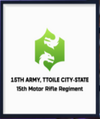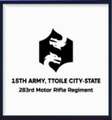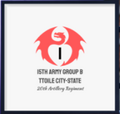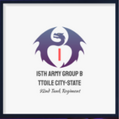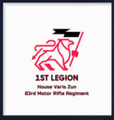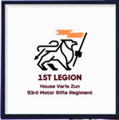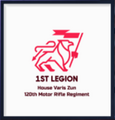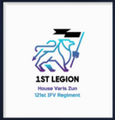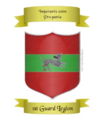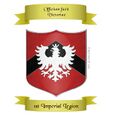Haru legionary
Military
Military Legions for The Sovereign Imperium of Machina Haruspex
- Military Age: 16 years of age
- Fit for military service annually: Age 16-49: 988,030
- Reaching military age annually: 2,500,000
- Active troops: 1,880,000
- Combat Deployable For All Legionary Branches: 436, 079
- Reserve: 2,632,000
- Combat Deployable For All Legionary Branches: 436, 079
- Logistic and Support: 1,155,000
- Ground Legionary: 280,000 personnel
- Aero Legionary: 165,000 personnel
- Naval Legionary: 150,000 personnel
- Strategic Rocket Legionary: 50,000 personnel
- Paratrooper Legionary: 62,000 personnel
- SOF: 18,000 personnel
Haru ballistic missile timeline
----------- Doctrine -----------
Ground Based
Terrain in The Sovereign Imperium is vast expanses of flatlands, though these are tempered by various environments consisting of semi-tropical, deserts, and heavy wooded areas buffered by mountain ranges at the exterior. Urban combat is also expected as The Sovereign Imperium has vast city state's that dot the landscape and thus must be accounted in the territory of terrain of theoretical combat areas.
Our general tactics involve a modern approach to " Blitzkrieg " and utilizes " vulym buehd " (focal point) in the planning of operations; it is a center of gravity towards which was made the point of maximum effort, in an attempt to seek a decisive action. Ground, mechanized and tactical air forces are concentrated at this point of maximum effort whenever possible. By local success at the vulym buehd, a small force can achieve a breakthrough and gain advantages by fighting in the enemy's rear. as “Tuh'd vettma, csycr!” (Don't fiddle, smash!)
To achieve a breakout, armored forces attack the enemy's defensive line directly, supported by motorized infantry, artillery fire and aerial bombardment in order to create a breach in the enemy's line. Through this breach the tanks can break through without the traditional encumbrance of the slow logistics of infantry on foot. The breaching forces never lose time by “stabilizing its flanks” or by regrouping; rather it continues the assault in towards the interior of the enemy's lines, sometimes diagonally across them. This point of breakout has been labeled a “hinge”, but only because a change in direction of the defender's lines is naturally weak and therefore a natural target for assault.
Naval Strategy
The Sovereign Imperium maintains a sizable naval force, and said force is split into four main fleets and twelve strike fleets that act in accordance with each other when deployed. At the core of the fleets are strike aircraft embarked on carriers and large-deck amphibious ships. Carrier strike groups and expeditionary strike groups often will operate together in theater, although they generally will steam independently to spread capabilities widely. Balancing the presence of carrier strike groups and expeditionary strike groups, as well as forming them into expeditionary strike forces on occasion, are key to achieving operational effectiveness and efficiency.
Providing sea-based security while concurrently waging a highly focused and agile offensive campaign, emphasizing the role of actionable intelligence, integrated allied forces if present, speed, maneuver, and deception. Much of this activity can be grouped under “maritime security operations,” reflecting a wide band of operational activities designed to secure and protect use of the seas from hostile threat.
The Imperial Navy also has the capabilities to accomplish a wide array of military operations. Such capabilities include wide-area sensing; communications and command and control; compliant and noncompliant boardings; precision strike; and self-defense.
The resultant constellation of widely dispersed, netted naval power integrated with HIN and allied forces across a unified battle space will operationalize the Imperial Navy's vision. Such forces will be well positioned and equipped to take the fight to the enemy. Attributes of their evolving operational role will include:
- Patience and dwell. Current Imperium military doctrine calls for overwhelming force and rapid maneuver, but the global war will require additional qualities. In many situations, naval forces will wait weeks, months, perhaps even years before striking. Such operations will involve patiently observing the environment to cultivate a rich understanding of sea and air traffic patterns, prepositioning ships to intercept terrorists at sea, and loitering offshore awaiting the proper time to strike key targets.
- Speed and precision. We also will need the ability to “sprint” when necessary to take out fleeting targets. This is best illustrated by strikes to kill hostile forces, or destroy hostile infrastructure and targeting mechanisms. The continuous networking of engagement-quality information will be critical to generating such speed, not only to guide weapons but also to allow real-time collaborative planning that generates the right amount of force at the optimal time and place.
- Timely intelligence and rapid analysis. The most important requirement of the global war setting is actionable intelligence. Our ability to find, fix, and kill hostiles from the sea is dependent on quality intelligence. To achieve it, we must integrate databases, streamline analysis, and develop information-routing aids that push vital information to the user when needed.
- Managing uncertainty. Successful warriors always have been skilled at operating effectively despite uncertainty. That ability will be especially important in the wars to come, in which we will have difficulty discerning adversary forces, methods, and intentions. We must use every tool at our disposal to minimize uncertainty, including human reporting and advanced technical intelligence collection techniques. We also must understand that the desire for “perfect” information is the enemy of “good enough” when fighting an adversary who will be visible to only one sensor or another for short periods of time. We must expect that some boardings and strikes will be unsuccessful in the narrow sense of the word. That is acceptable, even good, because such actions will keep the enemy on the defensive.
- Creating uncertainty. We must create uncertainty in the minds of our opponents. The greater the uncertainty in the minds of our opponents, the more difficult it is for them to generate a coherent defense, much less an effective offense. The Imperial Navy’s new fleet response plan helps achieve that goal by generating less predictable operating patterns, complicating enemy planning efforts.
- Preempting the enemy. The Sovereign Imperium's Strategic Command prescribes the selective use of preemption. Toward that end, maritime forces provide the Emperor with valuable options, ranging from long-range precision strike to the landing of ground forces. Best of all, maritime preemption options provide the speed so vital to success in the global conflicts to come, without dependence on foreign basing or permission.
- Enhancing economic security and stability. Because a primary goal of our enemies is economic dislocation leading to political collapse, maritime forces must provide security to offshore economic infrastructure and trade. Defeat of seaborne enemy forces, is central to that effort. Embracing this mission will lead to important changes in how naval forces train and operate. In many ways, the capabilities and operating patterns we must adopt in the global conflicts to come, will reflect the sea control lessons of the Battle of the Ranke Sea, in our home region of Europa. In the long-term struggle to enhance maritime security, small numbers of widely dispersed forces will dominate the battle space in their immediate vicinity, protecting vital assets and destroying those who would attack them.
Operational Initiatives
- Distributing netted striking power widely. The best defense remains a good offense, and in the war against enemy forces, that requires on-station forces capable of delivering swift and precise attacks. The Navy’s recent shift toward streamlined carrier strike groups and highly capable expeditionary strike groups is on target in this regard. The new fleet taking shape today is designed specifically to operate widely and efficiently while prepositioning unprecedented firepower from the sea.
- Protecting critical maritime infrastructure. Increasingly, global economic growth and prosperity rely on secure sea spaces. In the Ranke Sea, for example, the security of offshore oil platforms is critical to the economic health of coastal states. Protecting key economic assets from attack will be a growing role for military forces in every theater.
- Protecting sea-lanes. Defending shipping—large and small—extends the “Sea Shield” over thousands of individuals whose economic well-being is critical to winning any global conflict. Protection of critical straits in concert with allied partners is central to this effort, as well, as piracy is on the increase in many parts of the wurld. Reported attacks on ships were nearly 40% higher in the first half of 2003 than in the previous year, approaching 6 attacks per 1,000 ships.
- Employing sea bases. Minimizing the permanent presence of ground forces outside the Principality has long-term advantages, particularly in the Ranke region. Consequently, the importance of mobile, sovereign, and secure sea bases will grow in the years ahead. Such sea bases will allow us to preposition strike and shield forces, as well as serve as staging points for logistics that draw on high-speed transportation vehicles to provide timely support around the wurld.
- Sustaining readiness. The nature of unconventional enemies and the Navy’s new fleet response plan demand sustained readiness to surge and strike quickly. To meet that challenge, carrier and expeditionary strike groups should implement Strike Group Readiness Teams—trained senior officer groups within the lifelines of the strike groups—to fully leverage training investment opportunities whenever and wherever they arise.
- Expanding international military education and training. Military leaders play important roles in shaping national policies. Sharing Haruspex values with foreign naval officers early in their careers, and maintaining contact with them as they gain seniority, is a wise investment that will cultivate allies in our long-term effort to integrate all nations into the international community.
- Establishing naval liaison elements. Enhancing security in littoral areas is a coalition effort best achieved with local authorities in an integrated and sustained manner. Successful littoral defense requires an intimate knowledge of operating areas, cultures, and languages. The presence of naval liaison officers at key ports will serve that end, increasing situational awareness, intelligence, and trust.
- Maximizing boarding capabilities. Successful counterterrorism efforts rely on speed of execution and continual readiness to seize the initiative. To strengthen those capabilities, we should integrate training efforts with our coalition partners to ensure boarding teams are highly interoperable and optimally prepared for any contingency. Exciting synergies also exist with the House Legions communities to provide enhanced firepower when the situation requires.
- Investing in unmanned surveillance assets. Terrorism relies on stealth. Consequently, defense against terrorism requires continual vigilance. Yet, sustaining effective and comprehensive surveillance is tremendously expensive and asset intensive. The time is ripe to invest in unmanned surveillance platforms that operate on, over, and below the surface of the sea, to augment intelligence collection currently accomplished by manned naval platforms such as submarines and maritime patrol and reconnaissance aircraft. The recent forward testing of the Ferret, an unmanned surface vehicle with infrared and electro-optical capability, is a step in the right direction.
- Strengthening joint and coalition interoperability. The timely sharing of information between joint and coalition forces is fundamental to coordinating effective operations. Pursuant to that goal, ongoing initiatives to expand and standardize Principality information-sharing tools such as Knowledge Web and the allied shared Battlenet system will pay big dividends in combat effectiveness.
----------- Ranks -----------
Fleet Lord - They are nobles from the upper echelon and veteran officers. They command entire Houses, and may initiate combat if it serves the needs of the Council of the Nine.
Vice Lord - Second in command of the fleets as well as a noble from the upper echelon bloodlines.
General - Most of these veteran officers are from the main house lines and or the royal court. They are more then usually handpicked by the Fleet Lords and or the Council of the Nine, attesting to their abilities.
Sengar d'isto - A noble rank. They also are the head of the Prata Khan's for any one fleet or ground force.
Prata Khan - They are highly trained, professional soldiers from usually honoured houses or direct from the common citizenry. Prata Khan's are in charge of infantry, aerogroups, and so on. Consider them to be the middle rankings similar to a Captain.
Siet Khan - Second to the Prata's. Seasoned cleric, or soldier that has survived enough battles, and is well versed in leadership to inspire those around them.
Ji - Lower ranked officer class. Usually from the citizenry lines, some of the lower ranked houses as well.
Liet - Lower ranked officer class. Usually from the citizenry lines, some of the lower ranked houses as well. Highest position unless other circumstances permit, that a citizen not of honoured line can achieve.
Kenyet - Meaning " Brave ", the Kenyet is a seasoned non commissioned officer, and more then likely found as bodyguards and or pilots though infantry are also to be found. They have also recently been spotted as apart of the clerical units.
Yeyinde - Seasoned non commissioned officer. Most of the Yeyinde are in second in command of company's or aerowings.
Setg'in - Seasoned warrior, though not an officer. Has small leadership and just enough attained honour to hold command of a platoon.
Hult'ah - Soldier. Seasoned, seen a few battles, survived. Is proficient in several areas. Akin to a specialist or such in another army.
Aseigan - Your basic grunt. New to the ranks of the Haruspex legions, they are the those who are commanded and look upon the Hult'ah's for guidance.
----------- Brief Summary of Military Culture -----------
The military is extensively woven into the fabric of society and culture and is seen as a next step in many citizens step in life. There has been a mandatory two year service in existence, but generally most serve longer unless desiring other station in life.
Assessment of Officer Corps (Tactical Capabilities): Officers are extensively trained. The training curriculum includes university-level general education courses, traditional martial arts, Guerrilla/Anti-Guerrilla Warfare, escape and evasion, Subversion, Sabotage, Counter Terrorism, and Asymmetric warfare. After completing the two year junior portion of training, cadets are assigned for eight months to infantry regiments to become familiar with Legion weaponry and platoon leadership skills before resuming studies in the 1-year, 8-month senior program. Upon graduation, cadets became apprentice officers with the grade of Prata Khan (but who are treated as officers), and after the successful completion of four months probation in their assigned regiments, are formally commissioned as Ji (starting officer rank).
Assessment of Officer Corps (Strategic Capabilities): Officers are required to be flexible and aware of the battlefield conditions in order to make the correct decisions. Utilizing their training and equipment to the best of their abilities as well as those legionary under their command. With hundreds of years in making the academies as they are, officers from these sources define the Haru military complex in action and dedication.
Assessment of Logistical Capabilities: An army as vast as the one the Imperium holds cannot be effective without a strong service base. Haru service bases dot the landscape as do underground supply depots, fuel storage areas and so on.
Legion Locations Imperial Guard Legionary Deployment Komsomolsk-na-Amure, Tagmatine Defensive Border
o 1st Tank Regiment,
o 147th Artillery Regiment
o 1117th Aero Defence Regiment
o 136th Independent Intelligence Battalion
o 1174th Independent Anti-Tank Battalion
o 211st Independent Engineer Battalion
o 614th Independent Chemical Battalion
o 47th Independent Signal Battalion
o 190th Independent Maintenance Battalion
o 1063rd Independent Supply Battalion
o 370th Independent Medical Battalion
Special Forces Deployment
- 51st Parachute Landing Regiment
- 89th Light Armor Regiment
- 137th Parachute Landing Regiment
- 1182nd Artillery Regiment
- 107th Independent Aero Defence Regiment
- 322nd Independent Engineer Battalion
- 731st Independent Communications Battalion
- 43rd Independent Repair Battalion
- 110th Independent Transport Squadron
o 120th Guards Fighter Aviation Regiment
- 122nd Ground Attack Aviation Division
- 147th Separate Mixed Aviation Squadron
-------------------------------------------------------------------------------------
Tagnik Zun Deployments Prathen City-State
4th Tagnik Zun
- 429th Motor Rifle Regiment
- 503rd Motor Rifle Regiment
- 693rd Motor Rifle Regiment
- 292nd SP Artillery Regiment
- 481st Anti-aerocraft Missiles Regiment
- 141st Separate Tank Regiment
- 23rd Anti-aerocraft Mobile Regiment
- 20th Anti-aerocraft Mobile Regiment
-------------------------------------------------------------------------------------
Vek Elemmire Deployments Prathen City-State, Tagmatine Border
2nd Vek Elemmire
o 712th Interceptor Aviation Regiment
o 350th Interceptor Aviation Regiment
- 48th Composite Aviation Division
- 102nd Ground Attack Aviation Division
- 127th Separate Mixed Aviation Squadron
o 337th, Daist Separate Helicopter Regiments
o 373rd Secundus Separate Helicopter Regiments
o 112th Separate Helicopter Squadrons
o 162nd Separate Helicopter Squadrons
- 21st Anti-aerocraft Missiles Regiment
- 81st Anti-aerocraft Missiles Regiment
- 1st Radar Defense Regiment
- 6th Radar Defense Regiment
-------------------------------------------------------------------------------------
Buki Elghinn Deployments Yaris City-State, Tagmatine/Adapton Border
32nd Army, Yaris City-State
- 34th Motor Rifle Regiment
- 15th Separate Motor Rifle Brigade
- 2nd Legion Infantry
- 33rd Regiment Heavy Armor
- 34th Regiment Medium Armor
- 77th Light Combat Armor Regiment
- 78th Light Combat Armor Regiment
- 27th Motor Rifle Regiment
- 31st Anti-aerocraft Missiles Regiment
- 11th Radar Defense Regiment
-------------------------------------------------------------------------------------
Renor Elemmiire Deployments Cussian Territories
16th Army, Ulusk City-State
- 60th Tank Regiment
- 206th Motor Rifle Regiment
- 2nd Legion 'Sa'Karn' Motor Rifle Division
- 4th Legion Tank Division
- 26th Legion Tank Training Division
- 32nd Legion Motor Rifle Division
- 106th Legion Airborne Division
- 2nd Legion Alpine Infantry Division
- 3rd Anti-aerocraft Mobile Regiment
- 10th Anti-aerocraft Mobile Regiment
- 9th Radar Defense Regiment
-------------------------------------------------------------------------------------
Mzil Velven Deployments Defensive Border
67th Army, Taganrog City-State
- 70th Motor Rifle Regiment
- 71st Motor Rifle Regiment
- 72nd Motor Rifle Regiment
- 392nd Tank Regiment
- 50th Artillery Regiment
- 1203rd Anti-aerocraft Missile Regiment
- 125th Radar Defense Regiment
Cussian Territories 77th Army, Hades City-State
- 75th Motor Rifle Regiment
- 71st Motor Rifle Regiment
- 72nd Motor Rifle Regiment
- 392nd Tank Regiment
- 68th Tank Regiment
- 209th Motor Rifle Regiment
- 7th Legion 'Reina' Motor Rifle Division
- 12th Legion Tank Division
- 26th Legion Tank Training Division
- 32nd Legion Motor Rifle Division
- 50th Guards Training Artillery Regiment
- 1203rd Anti-aerocraft Missile Regiment
- 15th Radar Defense Regiment
15th Army, Ttoile City-State
-------------------------------------------------------------------------------------
Kabarria Deployments 1st Legion, House Varis Zun
-------------------------------------------------------------------------------------
Legion, Fleet, and Aero Banners
- 1st Imperial Legion - The 1st Imperial Guard is a full Legion is assigned duties within the Komsomolsk-na-Amure, upon the GHET Defensive Border
- 1st Imperial IAG - A ground attack aero-half legion in service to the greater sovereign imperium of Machina Haruspex. Currently deployed to the Northern Territories.
- 1st Imperial Legion - A full legion Guardians of that patrol and are deployed in and around the Imperial Central Ward and the Empress.
- 2nd Strike Fleet - Deployed to the Kaldana-Zharrian Frontier
- 2nd Imperial IAG - An Interceptor Aero-Half Legion that is currently deployed to North Korinon.
- 4th Tagnik Zun Legion - A full legion deployed in and around the city-state of Prathen

